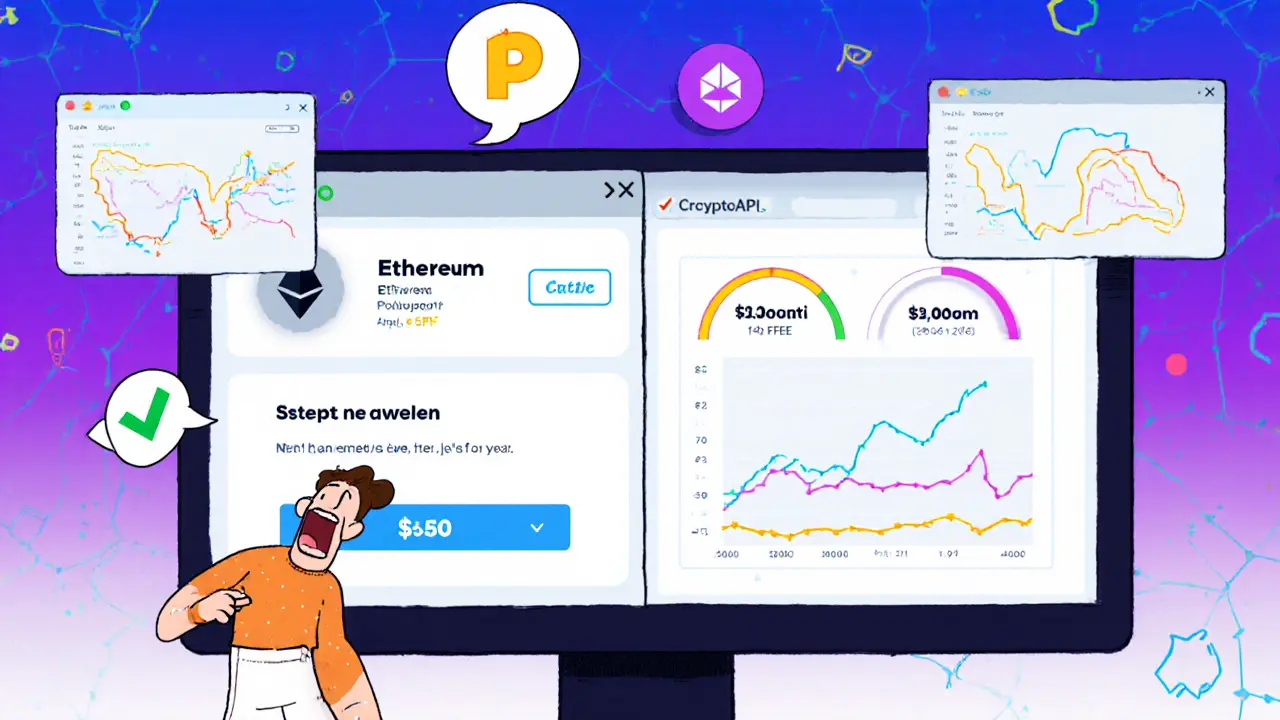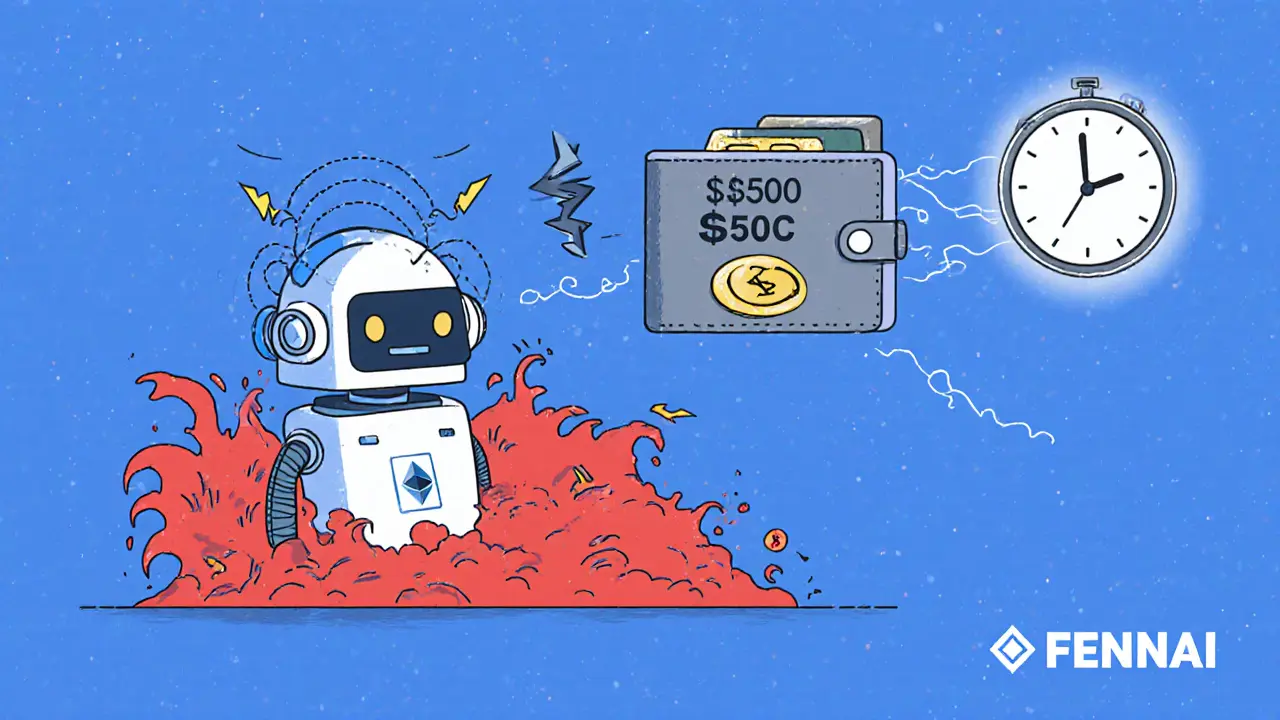Blockchain Transaction Fee Estimator
This tool provides approximate fee estimates based on current network conditions. Actual fees may vary due to real-time network congestion. Always verify fee estimates before sending transactions.
Ever sent a Bitcoin or Ethereum transaction only to watch it sit there for hours-while you paid way more than you needed to? Or worse, paid the minimum and got stuck for days? That’s not bad luck. It’s bad fee estimation.
Blockchain transaction fees aren’t fixed. They’re dynamic, driven by demand, congestion, and how smart your tool is at predicting what the network will charge next. In 2025, with Bitcoin hitting peak traffic on weekends and Ethereum Layer 2s handling millions of daily swaps, guessing your fee is like driving blindfolded. You need a tool that sees the road ahead.
Why Fee Estimation Matters More Than Ever
Back in 2017, a Bitcoin transaction cost $5. Today, during peak hours, it can hit $15 or more. Ethereum? After EIP-1559, fees became more predictable-but only if you understand the base fee + tip formula. Miss the tip, and your transaction lingers. Overpay by 200%, and you’re throwing money away.
It’s not just about cost. It’s about time. If you’re trading, paying a vendor, or interacting with a DeFi protocol, a delayed transaction can mean missed opportunities, liquidations, or lost profits. Accurate fee estimation isn’t a luxury-it’s the difference between success and frustration.
Real users report this daily. On Reddit’s r/bitcoin, people describe sending $100 worth of BTC only to pay $25 in fees because the wallet’s estimate was outdated by the time they hit send. Traders on BitcoinTalk say they’ve lost thousands by underestimating gas during NFT drops. The problem isn’t the blockchain-it’s the tool you’re using to guess the fee.
How Fee Estimation Tools Actually Work
These tools don’t pull fees from a magic list. They scan the mempool-the waiting room for unconfirmed transactions-and analyze what’s happening in real time.
On Bitcoin, they look at sat/vB (satoshis per virtual byte). The higher the mempool backlog, the higher the fee needed to jump the queue. Tools track how many transactions are waiting, what fees they’re offering, and how often blocks are filling up. Then they predict: if you pay X sat/vB, how long until your TX confirms?
Ethereum’s system is different. After EIP-1559, fees are split into two parts: the base fee (burned, set by the network) and the priority fee (tip to miners/validators). Your total fee = gas units × (base fee + tip). Estimation tools now predict both. If you’re doing a simple ETH transfer, you might need 21,000 gas. A smart contract? Could be 100,000+.
Advanced tools use machine learning. The FENN framework, developed in 2024, trains neural networks on historical mempool data, block confirmation speeds, and even time-of-day patterns. It learns that fees spike every Sunday morning in the U.S. and drop during Asian trading hours. That’s why some tools are 10-15% more accurate than others.
Top 5 Transaction Fee Estimation Tools in 2025
Not all tools are created equal. Here’s what’s actually working right now.
1. Cobo Fee API
Cobo’s API is the go-to for developers building wallets or trading bots. It supports Bitcoin, Ethereum, BSC, Polygon, and TRON. You send a request with your transaction type (transfer, contract call), source/destination address, and chain ID. It returns three tiers: fast, standard, and economy-each with a 95%+ confirmation probability within their time window.
What makes it stand out? Real-time updates every 12 seconds-faster than a new Ethereum block. It also adjusts for network congestion spikes, like during a major NFT mint. Developers report 98% accuracy under normal conditions. The catch? You need to handle API rate limits if you’re processing over 100 transactions per minute.
2. CryptoAPIs
CryptoAPIs is the Swiss Army knife for multi-chain fee estimation. It covers 50+ blockchains, including newer ones like Solana and Avalanche. Their dashboard shows live fee trends across networks, so you can compare Bitcoin’s current sat/vB with Ethereum’s base fee in real time.
They offer tiered pricing: free tier for 1,000 calls/month, then $29/month for unlimited. Their SDKs for Python and JavaScript are well-documented. If you’re running a crypto payment processor, this is your best bet. Users on GitHub praise its uptime and low latency.
3. Lightspark (Bitcoin & Lightning Focus)
Lightspark isn’t for on-chain Bitcoin. It’s built for the Lightning Network. If you’re sending small, frequent payments-like tipping on a crypto app or paying for coffee with BTC-on-chain fees are useless. Lightspark estimates routing fees across Lightning channels, predicting the cheapest path based on channel liquidity and recent success rates.
It’s not a traditional fee estimator. It’s a routing optimizer. And it works. Businesses using Lightspark report 40% lower average payment costs compared to manual on-chain routing.
4. Tatum Multi-Chain Fee Comparator
Tatum doesn’t just estimate-it compares. Want to send $500 worth of USDC? Tatum shows you the cost on Ethereum, Polygon, Arbitrum, and Optimism side by side. In 2025, sending USDC on Polygon costs $0.02. On Ethereum? $3.50. That’s a 175x difference.
Perfect for DeFi users who need to choose the right chain. Tatum’s UI is simple: pick your token, amount, and destination. It gives you the fee, estimated time, and even the risk of failure based on current congestion. No API needed-just paste your wallet address and go.
5. Blockchain.com Wallet (For Everyday Users)
If you’re not a developer, you don’t need an API. Blockchain.com’s wallet has one of the most accurate built-in estimators for Bitcoin. It shows three options: Low (2-4 hours), Medium (30-60 mins), High (under 10 mins). During the October 2025 Bitcoin congestion spike, it was within 8% of the actual confirmed fee 92% of the time.
It’s not fancy, but it’s reliable. And for most people, that’s all they need.

What to Look for in a Fee Estimation Tool
Not all tools are made for you. Here’s what to check before you use one.
- Network coverage: Does it support the chains you use? If you’re on Arbitrum, don’t pick a tool that only does Bitcoin.
- Update frequency: Tools that refresh every 30 seconds are better than those that update every 5 minutes. During congestion, delays matter.
- Fee tiers: Good tools give you options-not just one number. You should be able to choose speed vs. cost.
- Accuracy under stress: Ask: What happens when the mempool is full? Some tools overestimate by 200% during spikes. Others stay calm.
- Integration ease: Can you plug it into your app in under 2 hours? Or do you need a PhD in blockchain?
Pro tip: Avoid tools that only use historical averages. The blockchain isn’t a clock. It’s a live market. If a tool doesn’t scan the mempool in real time, it’s already outdated.
Common Mistakes and How to Avoid Them
Even with good tools, people mess up.
- Using wallet defaults: Most wallets set “standard” as default. That’s fine if you’re not in a rush. But if you’re swapping tokens before a price pump, you need “fast.”
- Ignoring gas limits: On Ethereum, if your contract call needs 150,000 gas but you set 50,000, your TX fails-and you still pay the fee. Always check the recommended gas limit.
- Not checking network status: Before sending, glance at Etherscan’s congestion meter or Bitcoin.com’s mempool graph. If it’s red, wait 15 minutes.
- Assuming all chains are equal: Sending ETH on Ethereum is expensive. Sending it on Polygon? Cheap. Know your options.
One user in Auckland sent $2,000 worth of SOL on Solana during a weekend surge. The wallet estimated $0.05. It ended up costing $1.20. Why? The tool didn’t account for recent spam attacks flooding the network. Always double-check.

Future of Fee Estimation: AI and Automation
By 2026, fee estimation won’t be something you set-it’ll be something that just happens.
Tools like FENN are already training AI models to predict congestion 10 minutes in advance. Imagine your wallet auto-switching to Polygon when Ethereum fees spike, or your DeFi bot delaying a trade until the base fee drops below $0.01.
Layer 2s like Arbitrum and zkSync are pushing this further. Their fee structures are simpler, but they still need smart estimation to avoid front-running or failed transactions. Expect more wallets to integrate AI-driven fee automation-no user input needed.
For now, though, you still need to choose wisely. The best tool isn’t the fanciest. It’s the one that matches your use case.
What’s the Best Tool for You?
Here’s a quick guide:
- Regular Bitcoin user: Use Blockchain.com wallet. Simple, accurate, no setup.
- Lightning Network spender: Lightspark. It’s built for microtransactions.
- DeFi trader on Ethereum: CryptoAPIs or Cobo. Real-time, multi-tier, API-ready.
- Multi-chain user: Tatum. Compare fees across chains in seconds.
- Developer building an app: Cobo or CryptoAPIs. Reliable, documented, scalable.
Don’t overcomplicate it. If you’re not coding, pick a wallet with a good estimator. If you are, use an API with real-time mempool data. And always, always check the network status before hitting send.
How do I know if my transaction fee is too high?
Compare your fee to what top tools like CryptoAPIs or Blockchain.com are showing for the same network and urgency level. If you’re paying 2x more than the "fast" option and your TX isn’t urgent, you’re overpaying. Also check mempool visualizers like BitcoinFees.21.co or Etherscan’s Gas Tracker-if the mempool is clear, you don’t need a high fee.
Why does my fee estimate change so fast?
Because the mempool changes every second. Thousands of transactions enter and exit the waiting line. If 10,000 new transactions flood in while you’re reading your wallet’s estimate, the fee needed to jump ahead rises instantly. That’s why API-based tools update every 10-30 seconds-they’re tracking live data. Static estimates are outdated before you click send.
Can I save money by waiting to send my transaction?
Yes, often. Bitcoin fees drop significantly after 2 AM UTC, when U.S. trading ends and European activity slows. Ethereum base fees usually fall after 7 PM UTC, when DeFi volume decreases. If your transaction isn’t time-sensitive, waiting 2-4 hours can cut your fee by 50-80%. Use Tatum or Etherscan to track trends before sending.
Are free fee estimation tools reliable?
Some are, some aren’t. Free tools like Blockchain.com’s wallet or Mempool.space give accurate estimates because they use real mempool data. But avoid obscure apps that don’t show their data source. If a tool doesn’t mention mempool analysis, real-time updates, or network congestion metrics, it’s likely using outdated averages-and that’s dangerous.
Do Layer 2 networks have different fee estimation needs?
Absolutely. Layer 2s like Arbitrum and Optimism have much lower fees, but their estimation works differently. They don’t rely on Ethereum’s base fee-they use their own congestion metrics. Tools like Tatum and Cobo now support Layer 2-specific estimators. If you’re using a Layer 2, make sure your tool knows it’s not on Ethereum mainnet.

lol so now we’re paying $15 to send bitcoin? lolololol. i bet the ‘experts’ who made this guide also own mining rigs and get paid in BTC. meanwhile i’m over here paying $8 for a $20 transaction because my wallet ‘recommended’ it. this whole system is rigged. the devs just want us to buy their ‘premium’ API so they can charge us even more. #blockchainisascam
The dynamic nature of transaction fees, as elucidated in the post, underscores a fundamental shift in blockchain economics. Real-time mempool analysis is not merely advantageous-it is indispensable for operational integrity. Tools that rely on historical averages are, by definition, obsolete in environments characterized by non-stationary demand. One must prioritize systems that update with sub-30-second latency to mitigate economic inefficiency.
Okay but can we just take a second to appreciate how insane it is that we’ve gone from $0.01 fees to $15 in under a decade? 😭 I remember when BTC was just for nerds and now it’s like paying tolls on the internet highway. 🚗💨 Cobo’s API is legit though-used it for my NFT bot and it saved me $200 in one week. Thank you, devs, for not being evil. 🙏✨
Let’s be real-Blockchain.com’s ‘accuracy’ is a joke. They’re not estimating-they’re guessing with a 92% confidence interval that’s statistically meaningless when the mempool is flooded with 500k unconfirmed TXs. And don’t get me started on ‘Tatum’-they’re just repackaging public Etherscan data like it’s proprietary. This entire article reads like a sponsored LinkedIn post by Cobo’s marketing team. If you’re using anything that doesn’t scrape the raw mempool via Bitcoind or Geth, you’re being fleeced. And yes-I’ve audited the code. You’re welcome.
Guys, I just want to say-I’ve been using CryptoAPIs since 2023 and I’ve never had a failed transaction. Like, ever. I used to be scared to send ETH during NFT drops but now? I just hit send and it’s confirmed in 8 seconds. You’re all overcomplicating this. Just use the tool that works. Also, if you’re still using a wallet that doesn’t show you the mempool graph? You’re not just lazy-you’re dangerous. 🚨
so like… i sent 500 dolars worth of eth on polygon and it cost me 2.50?? like wtf?? i thought it was supposed to be like 2 cents?? now im scared to send anything 😭
Y’all need to stop thinking of fees like a fixed cost and start thinking of them like traffic on the freeway. If you’re going to the mall at 5 PM on a Friday? You’re gonna wait. But if you leave at 2 AM? Smooth sailing. Same thing with blockchain. I wait until after midnight UTC to send anything non-urgent. My last three transactions? All under $0.10. I even set a reminder on my phone: ‘Wait for the dip.’ It’s not magic-it’s patience. And patience pays. Literally. 💸✨
This article is very long. I read only half. But I think fee estimation is not important. Why not just use Bitcoin? It is simple. No need for many tools. Just send and wait. Simple is better.
OMG I just realized I’ve been overpaying for months 😭 I used to just click ‘medium’ and pray. But after reading this, I checked Tatum and saw that sending USDC on Arbitrum was 98% cheaper than Ethereum. I moved all my stablecoins over and saved like $150 in a week. You guys, this is life-changing. I even told my mom and she’s now using Blockchain.com. She said, ‘I didn’t know I could do that.’ We’re all learning. You’re not alone. 💛
wait so if i use lightning network i dont pay blockchain fees at all? or like… less? i thought it was just for sending to friends
How quaint. You all treat fee estimation like some technical puzzle. But let’s be honest-the real issue is that blockchain was never meant for mass adoption. It was designed to be expensive, slow, and exclusionary. The ‘tools’ you praise? They’re just gatekeepers with better UIs. If you’re using any of these, you’re still playing their game. True decentralization? It doesn’t need an API. It needs a revolution.
Wait-so if I’m on Arbitrum, I shouldn’t be using Ethereum fee estimators? I thought they were all the same… I just used CryptoAPIs and it told me to pay $4.50 for a swap… but I’m on Arbitrum? 😳 I’m so confused now. I think I need to read this again. Maybe three times. And maybe use a dictionary. 😅
They want you to believe this is about ‘efficiency.’ But it’s not. It’s about control. Every time you use a fee estimator, you’re trusting a corporation that answers to Wall Street. Who owns Cobo? Who owns CryptoAPIs? Who owns the servers that ‘predict’ your fee? They’re all backed by venture capital. The blockchain was supposed to break banks. Now we’re just paying them in satoshis. Wake up.
Of course you’re overpaying. You’re using a wallet that doesn’t even let you manually set the fee. That’s like driving a Tesla and letting the GPS choose your speed. If you don’t understand sat/vB or base fee + tip, you shouldn’t be touching crypto. You’re a liability to the network. Go back to Coinbase. At least they’ll protect you from yourself.
Hey, I just want to say-this post helped me so much. I’m new to crypto and I was terrified of sending anything because I didn’t know how fees worked. I tried Tatum and it showed me the difference between chains in plain English. I even printed out the chart and stuck it on my fridge. You’re not alone. We’re all learning. And you’re doing great. 💪❤️
Fee estimation is not merely a technical challenge-it is a philosophical one. The blockchain, as a decentralized ledger, must reflect the collective will of its participants. Yet, fee mechanisms, by their nature, impose a hierarchy: those who pay more, move faster. Is this not the antithesis of egalitarianism? We must not confuse efficiency with equity. Tools may optimize for speed, but wisdom must optimize for justice. Let us not become mere consumers of gas, but stewards of consensus.
Wow. Another ‘guide’ from someone who thinks ‘API’ is a personality trait. You people are so obsessed with ‘accuracy’ you forgot the whole point of crypto: to bypass middlemen. Why are you paying for an API when you can just wait 2 hours? Or use Bitcoin Cash? Or, I dunno-stop sending so much shit? This isn’t Wall Street. It’s a blockchain. Let it breathe.
so i used lightspark and it worked but i think i sent it to the wrong person?? i cant find the tx on my wallet?? help??